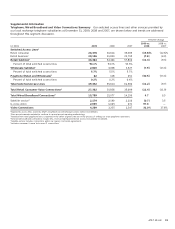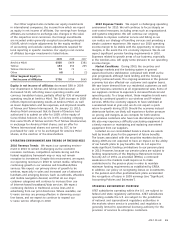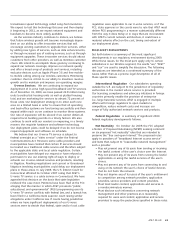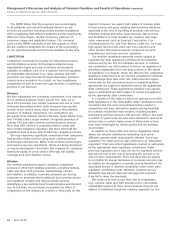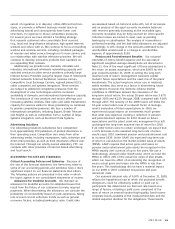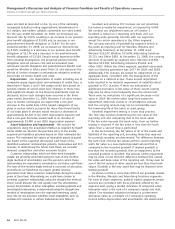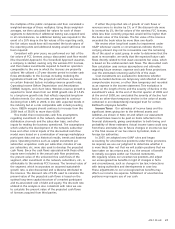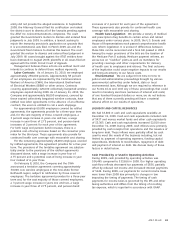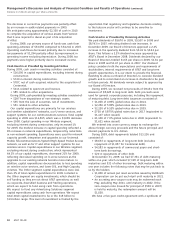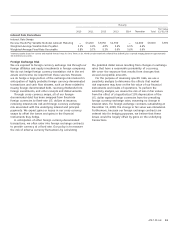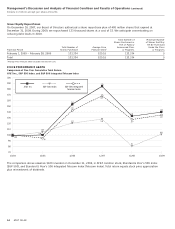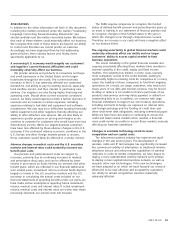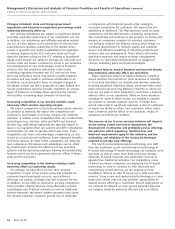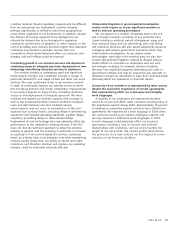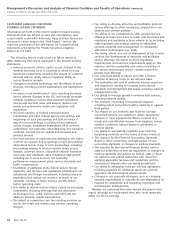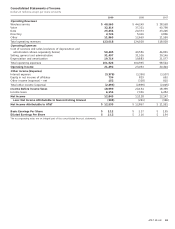AT&T Wireless 2009 Annual Report Download - page 51
Download and view the complete annual report
Please find page 51 of the 2009 AT&T Wireless annual report below. You can navigate through the pages in the report by either clicking on the pages listed below, or by using the keyword search tool below to find specific information within the annual report.
AT&T 09 AR 49
increases of 2 percent for each year of the agreement.
These agreements also provide for continued health care
coverage with reasonable cost sharing.
Health Care Legislation We provide a variety of medical
and prescription drug benefits to certain active and retired
employees under various plans. In 2009, the U.S. Senate and
House of Representatives each passed comprehensive health
care reform legislation. It is unclear if differences between
these bills can be reconciled and a final bill passed in 2010.
Among the major provisions of the bills are the taxation of
the Medicare Part D subsidy, Medicare payment reforms, an
excise tax on “Cadillac” plans as well as mandates for
providing coverage and other requirements for delivery
of health care to employees and retirees. The final outcome
of the legislation could cause negative impacts to our results
and bring uncertainty to our future costs.
Environmental We aresubject from time to time to
judicial and administrative proceedings brought by various
governmental authorities under federal, state or local
environmental laws. Although we are required to reference in
our Forms 10-Q and 10-K any of these proceedings that could
result in monetary sanctions (exclusive of interest and costs)
of one hundred thousand dollars or more, we do not believe
that any of them currently pending will have a material
adverse effect on our results of operations.
LIQUIDITY AND CAPITAL RESOURCES
We had $3,802 in cash and cash equivalents available at
December 31, 2009. Cash and cash equivalents included cash
of $437 and money market funds and other cash equivalents
of $3,365. Cash and cash equivalents increased $2,010 since
December 31, 2008. During 2009, cash inflows were primarily
provided by cash receipts from operations and the issuance of
long-term debt. These inflows were partially offset by cash
used to meet the needs of the business including, but not
limited to, payment of operating expenses, funding capital
expenditures, dividends to stockholders, repayment of debt
and payment of interest on debt. We discuss many of these
factors in detail below.
Cash Provided by or Used in Operating Activities
During 2009, cash provided by operating activities was
$34,445 compared to $33,656 in 2008. Our higher operating
cash flow reflects decreased tax payments of $836, partially
offset by reduced net income and increased interest payments
of $146. During 2009, our payments for current income taxes
were lower than 2008 due primarily to changes in law
impacting the timing of payments. The timing of cash
payments for income taxes is governed by the IRS and other
taxing authorities and differs from the timing of recording
tax expense, which is reported in accordance with GAAP.
entity did not provide the alleged assistance. In September
2008, the Attorney General filed his certification and asked
the district court to dismiss all of the lawsuits pending against
the AT&T Inc. telecommunications companies. The court
granted the Government’s motion to dismiss and entered final
judgments in July 2009. In addition, a lawsuit seeking to
enjoin the immunity provision’s application on grounds that
it is unconstitutional was filed. In March 2009, we and the
Government filed motions to dismiss this lawsuit. The court
granted the motion to dismiss and entered final judgment in
July 2009. All cases brought against the AT&T entities have
been dismissed. In August 2009, plaintiffs in all cases filed an
appeal with the Ninth Circuit Court of Appeals.
Management believes these actions are without merit and
intends to continue to defend these matters vigorously.
Labor Contracts As of January 31, 2010, we employed
approximately 281,000 persons. Approximately 58 percent
of our employees are represented by the Communications
Workers of America (CWA), the International Brotherhood
of Electrical Workers (IBEW) or other unions. Contracts
covering approximately 120,000 collectively bargained wireline
employees expired during 2009. As of January 31, 2010, the
Company and approximately 86,000 employees, covered by
these expired collectively bargained wireline contracts, have
ratified new labor agreements. In the absence of an effective
contract, the union is entitled to call a work stoppage.
For approximately 60,000 employees covered by ratified
agreements, the agreements provide for a three-year term
and, for the vast majority of those covered employees, a
3 percent wage increase in years one and two, a wage
increase in year three of 2.75 percent, and pension band
increases of 2 percent for each year of the agreement.
For both wage and pension band increases, there is a
potential cost-of-living increase based on the consumer price
index for the third year. These agreements also provide for
continued health care coverage with reasonable cost sharing.
For the remaining approximately 26,000 employees covered
by ratified agreements, the agreement provides for a four-year
term. The provisions of the tentative agreement are substan-
tially similar to the provisions of the ratified agreements
discussed above, with a wage increase in year four of
2.75 percent and a potential cost-of-living increase in year
four instead of in year three.
On February 8, 2010, the Company and the CWA
announced a tentative agreement covering approximately
30,000 core wireline employees in the nine-state former
BellSouth region, subject to ratification by those covered
employees. The tentative agreement provides for a three-year
term and, for the vast majority of those covered employees,
a 3 percent wage increase in years one and two, a wage
increase in year three of 2.75 percent, and pension band


